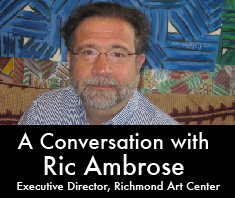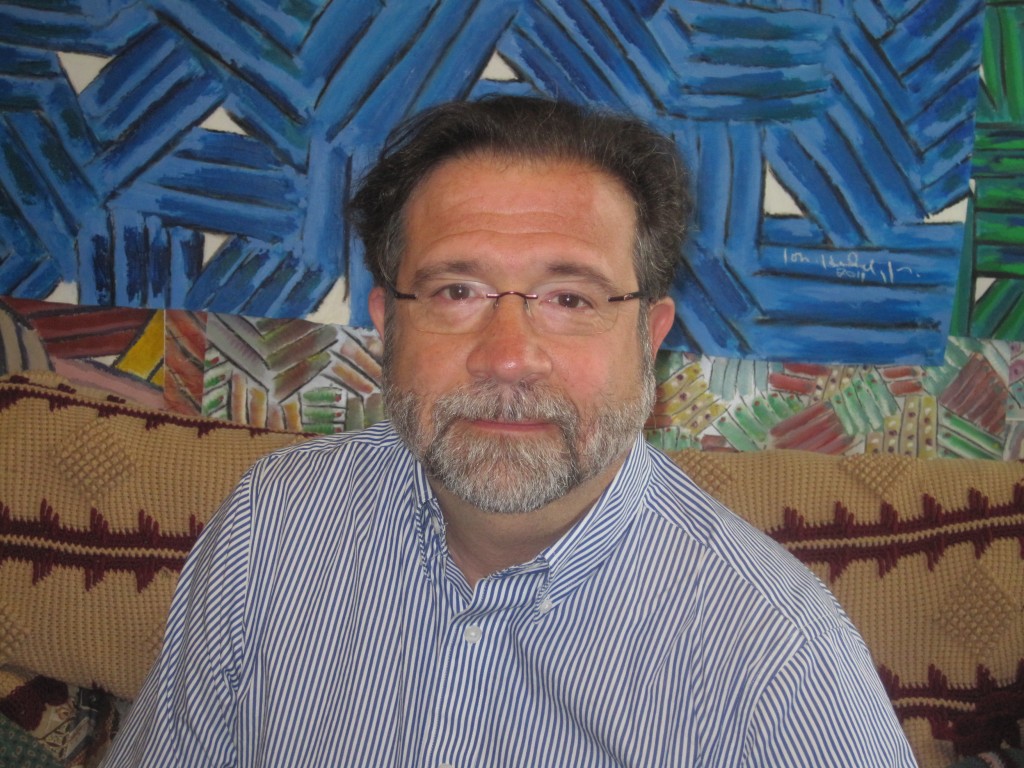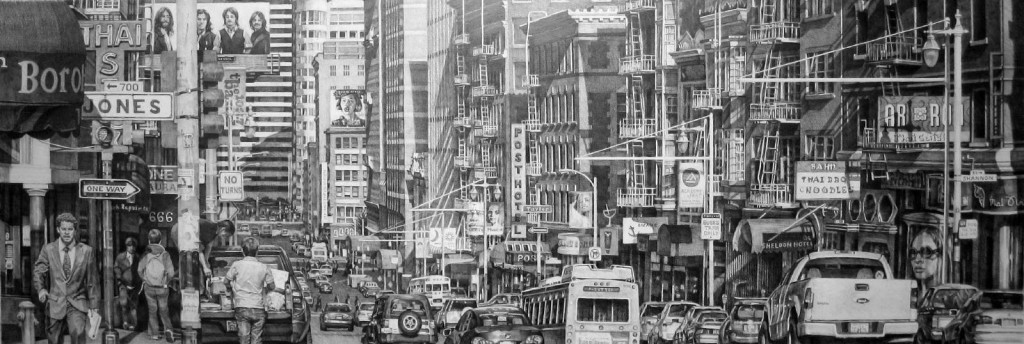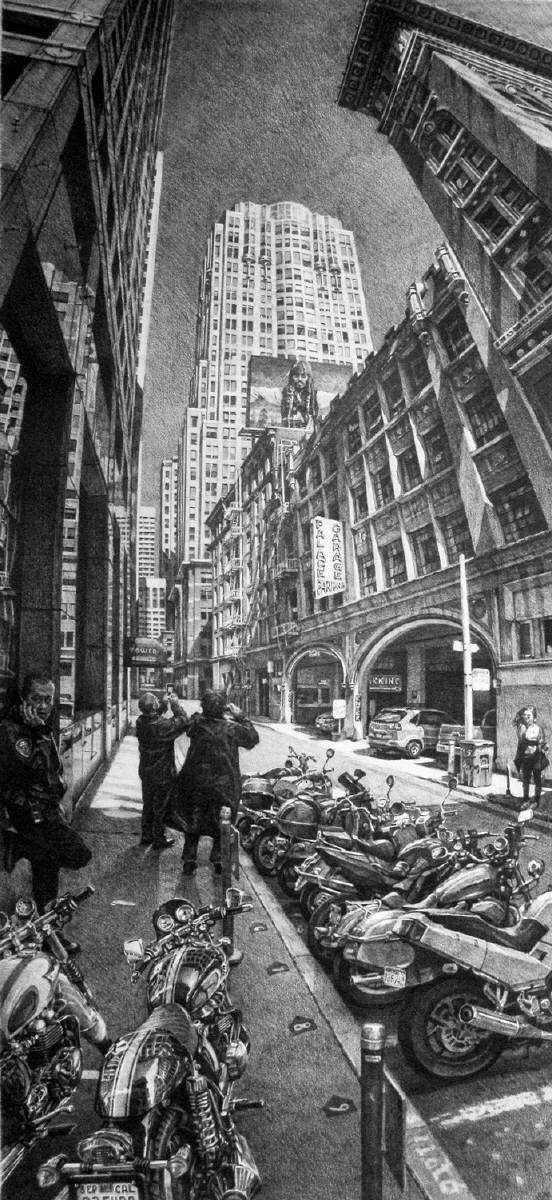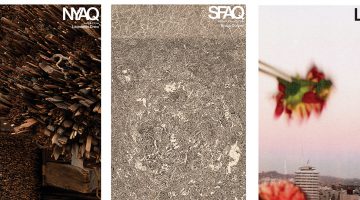Conducted by John Held, Jr.
Richmond, California.
September 14, 2012.
John Held, Jr: You just began your new position at the Richmond Art Center about a week ago.
Ric Ambrose: That’s correct. Just ten days ago. I arrived previously as the Executive Director of the Pacific Art League, which is an organization in Palo Alto, founded in 1921 for artists to meet, to critique and share art. It involved into a grassroots organization of mostly members and expanded its focus in studio art education and exhibitions of, not only local artists and members, but artists throughout the country.
When I arrived there two and one half years ago, just as the Richmond Art Center has experienced difficulty throughout the last decade, so did the Pacific Art League, and basically over [that time], we have turned the organization around in many ways – financially the atmosphere is more enthusiastic and supportive and people feel part of the art community. In fact, it’s the only place that artists can show their work and not compete with some of the major organizations, like the San Jose Art Museum and the Triton [Museum of Art, Santa Clara]. Now they can show at the Pacific Art League. It gives a chance for artists, whether they call themselves artists or not, a chance to showcase their creative endeavor, to express their pride in community A lot of people come to the Pacific Arts League for that reason.
And for me, it was my first [position] as Executive Director. My past experience with art museums had been as a curator, or deputy director of programs. This was a chance for me to work with artists – talk with artists. I didn’t have that opportunity, [rather] putting together historical shows and some contemporary artists. This was a chance to get back to my roots, because I started off as an artist, and I’m still a practicing artist. So, [I empathize with] the struggles, the ecstasy of becoming an artist, doubting yourself. We provide the tools to keep the inspiration moving.
JH: You mentioned your role as curator and noticed that you previously organized an exhibition of Viola Frey’s work.
RA: That was through the Nancy Hoffman Gallery. She was representing Viola Frey in New York. When I was the Director and Curator of Contemporary Art at the Clay Center in Charles, West Virginia, we had a Collector’s Club, which was a great organization of members, whose dues were used to purchase art for the museum. Each year, we would travel to a certain city and introduce our stakeholders to artists and galleries and bring some pieces back to consider for acquisition.
When I contacted Nancy, who I had worked with before on other exhibits, she said, “I can introduce you to Hung Liu and Viola Frey.” I had forty people with me, so on a bus tour we first went to Hung Liu’s studio, where she talked about her work and was an introduction to an artist no one knew. A number of people knew Viola Frey, in fact had work in their personal collection. We saw not only her new body of work, but the work that she’s had for the past forty or fifty years.
Our intention was to have one of her pieces for our collection – but not this year, we would consider next year. This is an introduction to an art group – lets think about this. Let’s see how one of her large pieces fit in the context to the collection, and see how people would react to that. Unfortunately, two or three months later, she died [July 26, 2004]. Nancy called us and said, “I’m holding a piece back for your organization – good price.” It was as man in a blue power suit. So I talked among our members and one individual, Honor Davis, stepped forward and said, “I’d like to purchase for the collection, because it reminds me of my father, who just passed away and always went to work in a power suit. And on top of that, I would like the exhibit to come to the Clay Center.”
Nancy was organizing a national tour of her [Frey’s] last body of work. I contributed an essay to the catalog. It was a fabulous experience installing [the show]. We had a large gallery – 10,000 square feet, and a truck backed up – we had about twenty of her larger than life size pieces. They came in body parts. We laid them out on the floor and took photographs of this eclectic collection of things. People walked around them, and then we assembled them slowly piece-by-piece.
It’s fascinating for people to come up see something that large that makes you feel like Alice in Wonderland. To see this incredible whirl and cacophony of not just surface, texture, color and pattern, but the attitude of the caricature she defines as male versus female – the gender issue. That was a great exhibit.
I was in Colorado as a curator. Colorado is known for it’s ceramic artists, and we curated a show where we picked six artists, who then turned around and invited two others who inspired their work. It was a collection of three dozen artists: Robert Arneson, [Peter] Voulkos, Robert Turner, Richard Shaw, Robert Brady…a who’s who. It was a grassroots effort by Colorado artists, who wanted to share their enthusiasm for ceramic art, and then bring people to artists whose work they haven’t been exposed to.
- Richard Ambrose Band of Urbanity. 2011.
JH: Contemporary ceramics is a very exciting field.
RA: The Richmond Art Center has a strong ceramic program. They have done a number of extraordinary exhibits of ceramic artists going back to it’s beginning. Just lately, we had the [Stephen] De Staebler exhibit, just before he passed away.
JH: The Wanxin Zhang exhibit…
RA: …this past Spring.
JH: The Richmond Art Center has a distinguished history. I think it goes back to 1936?
RA: It was formed in 1936, but the current building was not built until 1951, and that was a City effort – the first concept where a civic complex included an art center. 1936 was just about the time SFMOMA was founded [San Francisco Museum of Art, 1935], so we have sort of a parallel history. First, [we are both] in a downtown building. Hazel Salmi, was the founder, the pioneer bringing art to Richmond, making sure that people had access to art. She did it on a bike and a trunk [taking art to the community].
Even through the war effort – there was a large ship building industrial complex in Richmond – an effort was made to get art out to the people, at work, as well as centers. Then the concept of the Art Center evolved. The building is a very dynamic space –the combination of museum-type galleries mixed with incredible studio spaces for ceramics, weaving, metalwork, jewelry, two-dimensional painting and drawing. So, in many ways the Art Center is probably the only site of its type in the East Bay that has that caliber and size.
The effort now is to reconnect, not just with Richmond but to the East Bay. The Art Center has struggled over the last ten years. We are still maintaining its legacy, but we must do so in a more progressive way, an energetic way that we are looking at. Also, we still must be mindful and connect with our community. The City of Richmond has been very supportive, not only in maintaining the facility, but providing critical funds to make sure we have a foundation to do programming. This year we will be expanding our outreach to in-school, after school, community centers, homeless centers. There is a great opportunity for the Art Center to become more transparent, not as a physical space, but as an organization and a state of mind.
What is interesting to me, being relatively new, is when we had Solano Fair last weekend. We had a presence there, and the people who walked up, they knew the Richmond Art Center. They had been there, and they applauded what we do. Others who did not know of us were very interested in what we did. There were teachers who wanted to teach there. Artists wanted to take classes there. It was a great way to connect with the people who came by.
JH: You have an exhibition schedule for the fall.
RA:. The shows open tomorrow (September 15) and the reception is a week from tomorrow (September 22). There is an artist talk from noon to 2:00 pm, and the reception is from 2:00 pm to 4:00 pm.
JH: Are these exhibitions that you’ve inherited?
RA: Yes. We have an exhibition director, Emily Anderson, who’s been onboard for two years. She is responsible for framing the exhibition schedule. We have some annual commitments to a number of organizations. “The Art of Living Black” is one of them. That happens in the winter quarter. We have a [partnership] with the Association of Clay and Glass Artists of California. They have an exhibition that is opening up tomorrow. We also have an international juried exhibition on enameling. And again, you can see the connection to the strength of the Richmond Art Center –there are sixty exquisite pieces of enameling, not just traditional approach, but non-traditional sculptural, functional and non-functional works.
We have a traveling show, which was curated locally, “Hobos to Street People: Artists’ Response to Homelessness from the New Deal to the Present,” which mirrors the seventy-five year history of the Richmond Art Center; a subject which was swept under the carpet, but became more of a social issue under the WPA [Works Progress Administration] and went under again, and now has becoming more conscious.
JH: The period of the Richmond Art Center I’m most familiar with was the early seventies, when Hayward King, who was one of the Beat era artists, hired Tom Marioni. At that time, the Richmond Art Center was perhaps the most progressive art space in California paving the way for West Coast Conceptualism.
RA: That’s correct. In the 60s and 70s, the Art Center was one of the few places artists, who lived in the Bay Area, could show their work during a formative period. The Richmond Art Center took advantage of that, and did an exceptional job.
The list of artists who have shown at the Richmond Art Center, not just once but innumerable times –Robert Bechtle, Robert Hudson, who showed six or seven times, [Wayne] Tiebaud [is impressive]. Peter Voulkas did an artist-in-residence program at the Richmond Art Center. Hung Liu. SFMOMA is doing a show on Jasper Johns and Jay DeFeo [opening November 3, 2012], who had their first West Coast exposure at the Art Center in the 1960s.
JH: I’m interested in your work as an artist. You show with Hespe gallery in San Francisco. Large, technically proficient works of graphite on paper… How does your work as a practicing artist impact on your career as an arts administrator?
RA: Well, my art-making career is bookended by my art museum experience. When I graduated with an MFA, I was a practicing artist showing at a number of institutions. I was represented by several galleries. At the time, I was doing scroll like drawings, much larger than I’m doing today. They were 18 to 25 feet long. A lot of that was influenced by Chinese art. My wife, who I met at the University of Oregon, received her Masters in Chinese Art History.
I was fascinated by the sense of time and space in Chinese [thinking], in sense of memory, where you unroll the scrolls and digest what’s there, and then unroll the next section. It’s a sense of journey and memory. My initial work was mostly cityscapes without people. It was a sort of a meandering path, so when you looked at the work, you had a panoramic view that went beyond your peripheral perception. There is a sense of walking up to the drawing and literally walking along the path of the drawing. So, there is a conceptual [aspect] of time and space, which intrigued me.
When I started off as a curator, there was a gentleman in Littleton [Colorado], where I was living, who was tired of teaching drama at the high school, and wanted to take on a renovation project in downtown Littleton, transforming an old post office into an art gallery and performing arts space. He was looking for someone who could put shows together, or at least install shows. I volunteered for about a year, and then he mentioned that there was director of an art center who liked the way I put the shows together, and their was a vacancy – would I be interested in applying. I did and got the job. That really started by career in the museum profession. That gentleman is Ken Foster, who is now the Executive Director of the Yerba Buena Art Center [San Francisco]. So, I’ve kind of come 360 [degrees] here.
When I became a curator, my art making slowed down, virtually stopping. So, for twenty years, I didn’t draw. Only when I came back to California, when my wife and I moved to El Cerrito, and our kids graduated, I had an opportunity to get back to my drawing. Of course, there was a huge gap. I had to develop a new body of work so I could see if someone would be interested in carrying my work. I contacted a dozen galleries in the downtown [San Francisco] area, and Hespe [Gallery] was the first to say, “I love your work. I want to show your work.” I’m balancing my obligations as Director of the Richmond Art Center, and spending some time to continue to make my work.
My work has changed. It’s still in a scroll-like format, but it’s now vertical and horizontal. It’s a little shorter. I’ve introduced people, because I think the Bay Area is such a fascinating environment to capture. I get an idea and I shoot hundreds, if not thousands, of photos. I try to reconstruct a scene using images of people from different scenes, trying to recreate a narrative – people walking, interacting, not interacting, a mass of signage and buildings, and energy and sound, all in a black and white way, because there’s a sense of timelessness when you work in black and white.
JH: Do you work with projected images or free hand?
RA: Free hand. I’ll make a collage of what the basic composition is, and then it’s all hand drawn. Then I start to manipulate and change elements as I keep drawing until I finish it. I don’t rely on photographs. I react to the drawing itself.
JH: I’m very happy to see an art administrator who is also an artist, because I think they have more sensitivity…
RA: Absolutely. Without spoken words, they can communicate more effectively to artists. There is a camaraderie.
JH: I’d like to end there, and thank you for your time, wishing you success in your new position.
